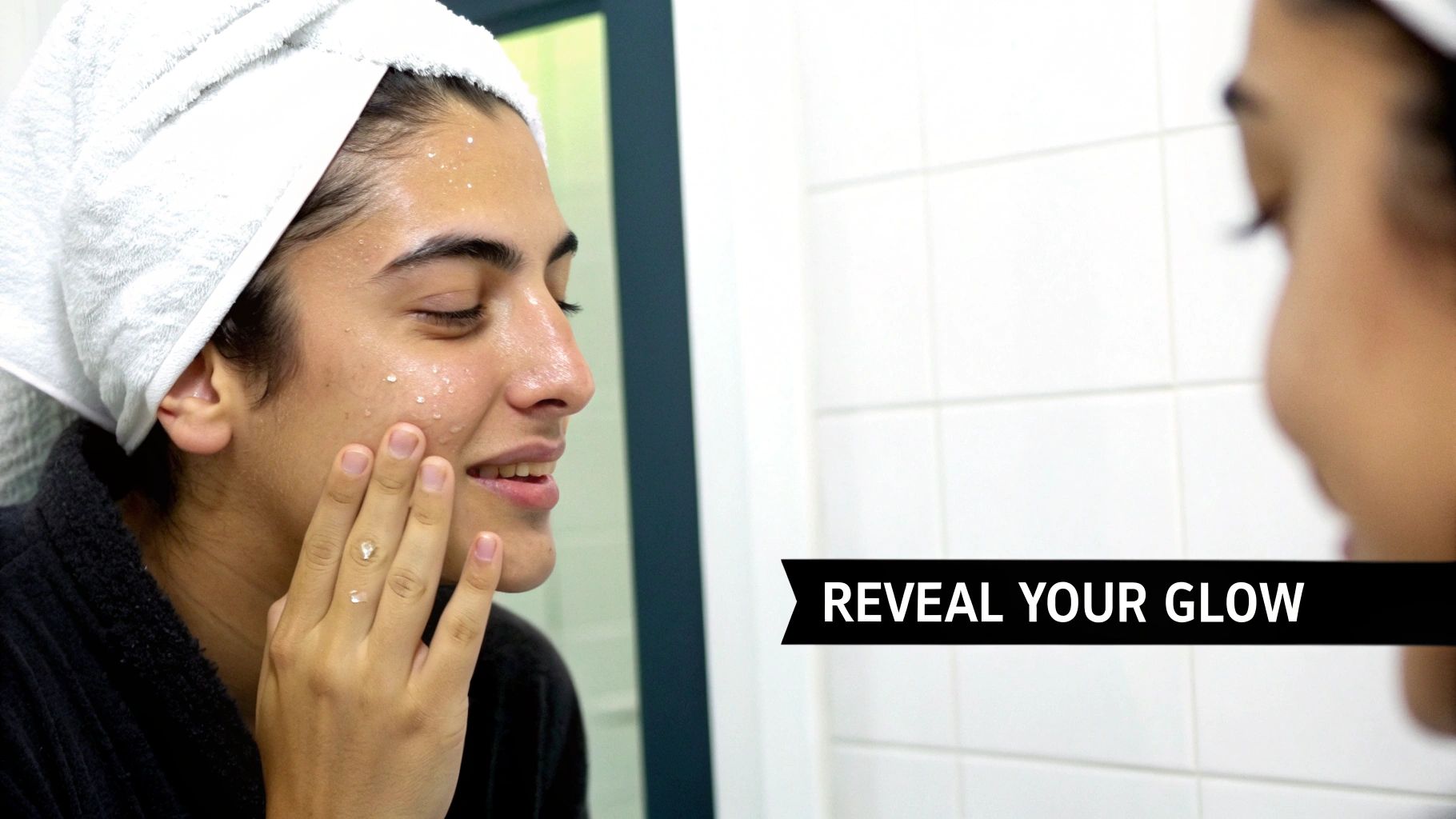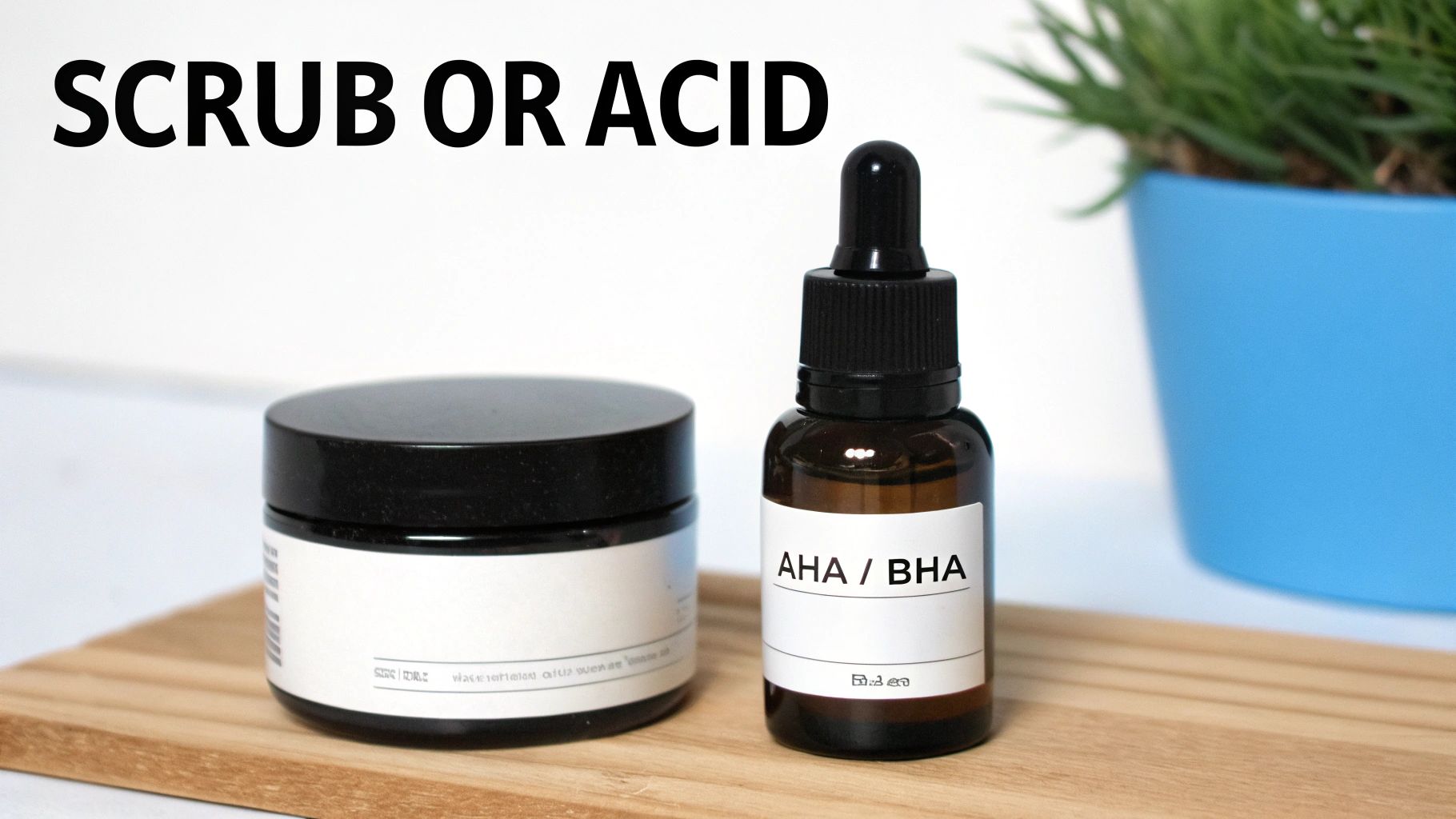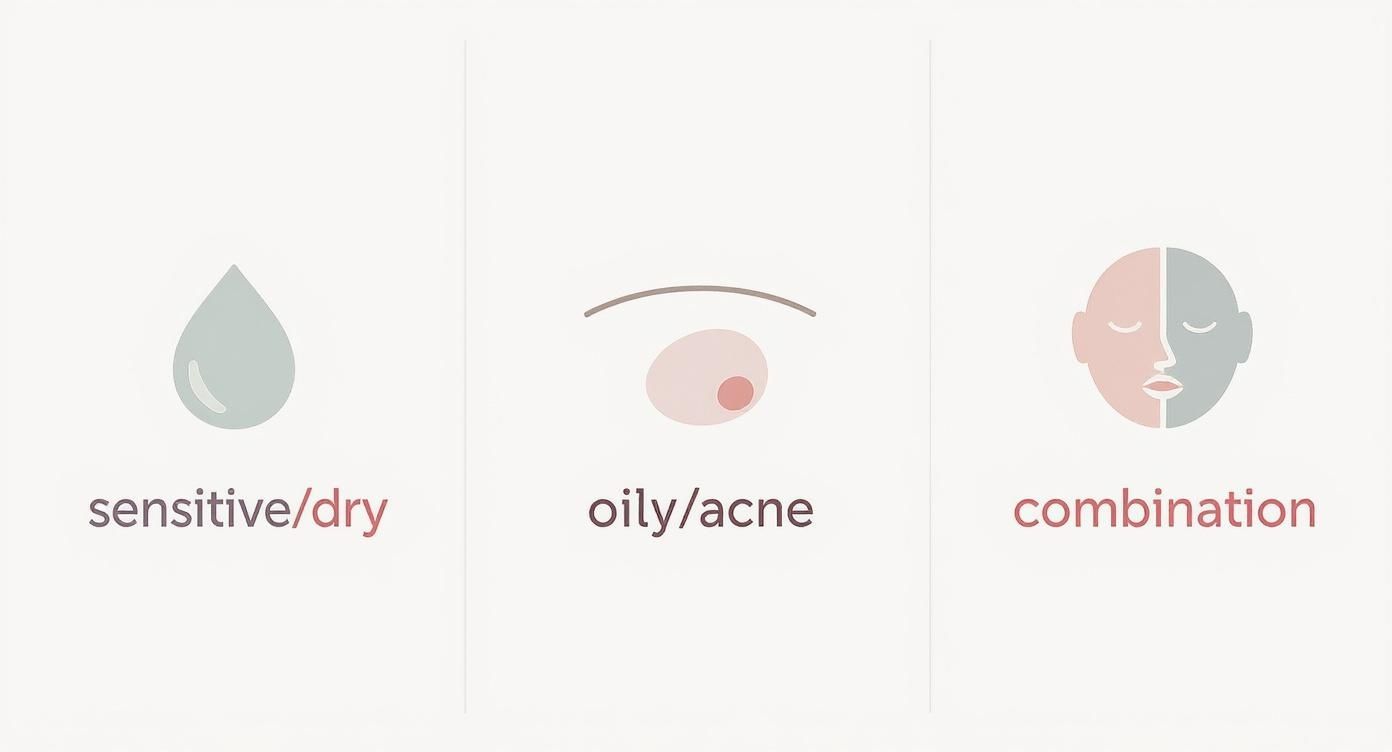How to Exfoliate Properly for Radiant Skin
- Web Dev
- Oct 24
- 11 min read
Proper exfoliation isn't about scrubbing your skin into submission. Far from it. Think of it as a gentle, almost meditative ritual of sloughing away the old to reveal the new, vibrant skin waiting just underneath. Getting this right is the key to unlocking a smoother, healthier-looking you.
Your Journey to Radiant Skin Starts Here
Welcome to your definitive guide to exfoliation. Forget everything you think you know about harsh scrubs and abrasive routines. We're here to talk about the art of gentle renewal – a process that reveals your skin's innate glow. Let’s move past the one-size-fits-all advice and find a rhythm that works in harmony with your unique skin.

Think of it this way: exfoliating properly is the first, most crucial step to making every other product in your cabinet work harder. Get this right, and you'll see a world of difference. Your expensive serum will absorb better, your moisturiser will feel more effective, and even your makeup will sit more smoothly.
Unclog Pores: Say goodbye to frustrating breakouts.
Brighten Up: Wake up a dull, tired-looking complexion.
Smooth Things Over: Drastically improve your skin’s texture.
It’s more than just creating a smooth canvas, though. Exfoliation is also a fantastic way of addressing common concerns like blackheads and pores. It’s like a spring clean for your face, clearing the way so your serums and moisturisers can sink in deep and do their job. A clean slate is everything, which is why you should also have a read of our guide on how to cleanse your face properly.
It seems more and more of us are catching on. The UK exfoliator market is booming, with experts predicting it will reach a market size of over £60 million by 2033. This isn't just a fleeting trend; it’s a real shift towards wanting effective, at-home treatments that deliver professional results.
Choosing Your Perfect Exfoliation Method

Finding the right way to exfoliate is less about following a trend and more about listening to your own skin. It’s a bit like matchmaking; the goal isn’t to find the strongest product, but the one that’s just right for you. To get there, let’s explore the two main paths you can take: physical and chemical exfoliation.
Physical exfoliation is what most of us think of first. It’s the hands-on approach using gentle scrubs, soft-bristled brushes, or fine powders to manually buff away the layer of dead cells on the surface. You'll love this method if you enjoy that instantly gratifying feeling of softness and smoothness right after you rinse.
Chemical exfoliants, on the other hand, work their magic more discreetly. Instead of scrubbing, they use intelligent ingredients like acids and enzymes to dissolve the bonds holding dead skin cells together, letting them slough away naturally. This approach often leads to a more even, deeper renewal without any physical friction, perfect if you want results that build over time.
Physical vs Chemical Exfoliation At a Glance
Feeling a bit stuck? This quick comparison should help you pinpoint the best starting point for your skin type and what you want to achieve.
Feature | Physical Exfoliants (Scrubs, Brushes) | Chemical Exfoliants (AHAs, BHAs) |
|---|---|---|
Best For | Oily, combination, and less sensitive skin types seeking instant smoothness. | All skin types, especially those with sensitive skin, acne, or sun damage. |
How It Works | Manually sloughs off dead skin cells from the surface with friction. | Dissolves the "glue" holding dead cells, allowing them to shed naturally. |
Key Benefits | Provides immediate tactile results, boosts circulation, simple to use. | Offers even exfoliation, targets specific concerns like pores and fine lines. |
Potential Downsides | Can cause micro-tears or irritation if too harsh or used too aggressively. | Can cause sensitivity if overused or the wrong acid is chosen for your skin. |
Ultimately, there's no single "best" method—only what's best for your skin's current needs. Some people even find a happy balance by incorporating both into their routine at different times.
Getting to Grips with Chemical Exfoliants
The word "chemical" can sound intimidating, but don't let it put you off. We're not talking about harsh, stripping formulas. Modern chemical exfoliants are incredibly sophisticated and designed to renew your complexion with precision and care. They are your secret weapon for tackling specific issues like dullness or clogged pores.
Here’s a simple breakdown of the main players:
Alpha-Hydroxy Acids (AHAs): These are water-loving acids that work wonders on the skin’s surface. Glycolic and lactic acids are fantastic for improving texture, fading discolouration, and bringing back a youthful glow. They’re a brilliant choice if your main concern is dry or sun-damaged skin.
Beta-Hydroxy Acids (BHAs): These are oil-soluble, which is their superpower. It means they can travel deep into your pores to clear out congestion and excess oil. If you have oily or blemish-prone skin, salicylic acid is your absolute best friend.
Poly-Hydroxy Acids (PHAs): Think of these as the gentle giants of the acid world. Their larger molecule size means they work exclusively on the surface without penetrating too deeply, making them perfect for you if you have sensitive or reactive skin that can't tolerate other acids.
If you're intrigued by the idea of a more intensive, professional-led treatment, our guide explains what a chemical peel treatment is and its benefits in greater detail.
This shift towards finding a perfect, personal match is happening across the board. While the UK skincare market saw steady growth of 7.9% in 2024, the real story is in personalisation. It’s no longer about a one-size-fits-all product; it’s about finding a routine that truly understands and works for you. You can explore more on this trend with these UK exfoliator market insights from Deep Market Insights.
A Personalised Approach for Your Skin Type
Your skin has its own unique language. Learning to listen to it is the real secret to unlocking its glow. A one-size-fits-all approach to exfoliation just doesn't work; what’s a game-changer for your friend might be a disaster for you. The magic happens when you tailor your routine, choosing methods that truly respect what your skin is telling you.
This isn’t about following the latest trend. It’s about starting a thoughtful conversation with your skin. Once you understand its distinct personality, you can exfoliate in a way that reveals a complexion that’s not just smooth, but genuinely healthy and strong.
For Oily and Blemish-Prone Skin
If you have oily skin, you know the struggle with congested pores and breakouts all too well. For you, exfoliation is less about a surface-level polish and more about a crucial deep clean. This is where beta-hydroxy acids (BHAs) come in, and salicylic acid is your absolute best friend.
Unlike other exfoliants, salicylic acid is oil-soluble. This means it can actually get down into your pores to break up the gunk and oil that cause spots in the first place. It’s incredibly effective. Here in the UK, we're really starting to appreciate how exfoliation can help manage sebum and prevent acne, and the market reflects that. You can see just how much this has grown in these UK facial skincare market insights.
For Dry or Sensitive Skin
When your skin is dry or easily irritated, the very word "exfoliate" can sound a bit scary. I get it. The key is to be incredibly gentle and choose options that hydrate while they work, protecting your delicate skin barrier. Harsh, gritty scrubs are definitely out for you.
Instead, turn to milder chemical exfoliants.
Lactic Acid: This is a fantastic AHA that not only exfoliates but also helps your skin hold onto its own natural moisture. You get the smoothness without the tightness.
Polyhydroxy Acids (PHAs): Think of these as the gentler cousins of other acids. Their molecules are larger, so they work on the very surface without penetrating too deeply and causing a reaction. They are your safest bet.
Jojoba Beads: If you really love the feel of a physical scrub, look for one with perfectly round, biodegradable jojoba beads. They won’t cause those tiny micro-tears that rough scrubs can.
Dealing with sensitivity is a journey, and figuring out what sets it off is half the battle. If this sounds like you, our guide on what causes skin sensitivity is packed with practical advice to help you find some peace.
Remember: The goal is renewal, not irritation. A gentle touch and the right product will leave your skin feeling soft and comfortable, never stripped or tight. Listen to what your skin tells you.
For Combination Skin
Ah, combination skin. This requires a bit of clever strategy. You’re essentially dealing with two different skin types on one face—usually an oily T-zone (forehead, nose, and chin) with drier cheeks. This is where you can get smart with "multi-exfoliating."
There’s no rule that says you have to use one product all over. In fact, you shouldn’t! Treat each area for what it needs. You might find that using a BHA-based exfoliant just on your T-zone keeps the oil in check, while a hydrating lactic acid product works beautifully on your cheeks. This bespoke approach ensures every part of your face gets exactly what it needs to thrive.
Your Step-by-Step Exfoliation Ritual
Right, let's get to the good bit—turning all this knowledge into a beautiful, mindful ritual. Don't think of this as just another step in your routine. This is a moment you carve out for yourself, a mini spa-like experience that rewards you with genuinely glowing skin.
It all starts with a clean slate. Seriously, before you even think about reaching for that exfoliant, you have to thoroughly cleanse your skin. A gentle cleanser and some lukewarm water will do the trick, washing away makeup, oil, and the day's grime. Trying to exfoliate dirty skin is like polishing a dusty table; you’re just moving the mess around.
Perfecting Your Application Technique
How you apply your product is just as important as which one you choose. The goal is always to get the glow without the irritation. Remember, your skin is delicate—treat it with the kindness it deserves.
For Physical Scrubs: Scoop out a small, pea-sized amount and apply it to damp skin. Using just your fingertips, work the scrub in gentle, light, upward circular motions for about 30 to 60 seconds. Please, never press hard or scrub like you're trying to remove a stain. That can cause micro-tears in the skin. Let the product do the heavy lifting.
For Chemical Exfoliants: These beauties, whether they're serums, toners, or pads, work best on dry, clean skin. A few drops on a cotton pad or into your palms is all you need. Gently pat or sweep it across your face, making sure to avoid the delicate eye area. There's no rubbing required here at all. Just let it absorb and work its magic.
This handy visual guide can help you pinpoint which exfoliants are best suited to your skin's unique needs.

The real takeaway here is that there’s a perfect match for every single skin type, so you can slough away dead cells effectively without stressing your skin barrier.
A Moment of Mindfulness: Always listen to your skin. If you feel any significant stinging or burning from a chemical exfoliant, rinse it off straight away. A gentle tingle can be normal, but discomfort is your skin's way of saying "no, thank you."
Once your time is up—whether that’s a minute for a scrub or the directed leave-on time for a chemical peel—rinse everything off thoroughly with lukewarm water. Gently pat your face dry with a soft, clean towel. Now, your skin is perfectly prepped and thirsty for all the nourishing serums and moisturisers to come.
Looking After Your Skin Post-Exfoliation (And What Not to Do)
Think of your freshly exfoliated skin like a delicate new leaf – it’s bright and new, but it needs a little TLC to really thrive. What you do right after you exfoliate is just as crucial as the exfoliation itself. This is your moment to seal in that gorgeous glow and help your skin barrier stay strong and healthy.
Your first move, and it's non-negotiable, is hydration. Your skin is now perfectly prepped to soak up moisture, so don't miss this opportunity. This is the time for soothing serums and rich moisturisers that will replenish and protect.
Your post-exfoliation dream team includes ingredients that calm and restore. Look for hyaluronic acid for a massive drink of water, ceramides to help rebuild your skin’s natural defences, and niacinamide to take down any lingering redness. Your skin will thank you for it.
And of course, sun protection is an absolute must. Exfoliating brings fresh, new skin cells to the surface, and they are far more vulnerable to sun damage. Slathering on a broad-spectrum sunscreen every single morning is the best insurance policy you can have for your skin, protecting all your hard work and preventing future dark spots.
Common Missteps to Avoid
Part of getting exfoliation right is knowing what not to do. It’s so easy to get a bit over-enthusiastic, but when it comes to your skin, a gentle hand always wins the race. Here are a few common traps people fall into.
Going Overboard: This is the number one mistake I see. If your skin is constantly red, feels tight, or has an almost waxy, shiny look to it, you need to step back. Your skin is telling you it needs a break. Listen to it.
Mixing Too Many Actives: Be really careful about piling on other strong ingredients like retinol or potent vitamin C serums right after you exfoliate. Using them all at once is a recipe for irritation. A much safer bet is to use them on alternate nights. This gives your skin the benefits of each without overwhelming it.
Scrubbing Like You're Sanding a Floor: If you're using a physical scrub, remember to be gentle and let the tiny particles do the work for you. Pushing too hard can create tiny micro-tears in your skin, leading to inflammation and sensitivity – the exact opposite of what you’re trying to achieve.
Your Exfoliation Questions, Answered
Feeling good about your skincare routine comes from knowing you’re doing it right. As you start to explore exfoliation, it’s completely normal for a few questions to pop up. Let’s get those sorted so you can feel confident and start working towards that gorgeous, healthy glow.
Think of this as your friendly guide, not a list of strict rules. Your skin has its own personality, and the best approach is always one that pays attention to what it’s telling you.
So, How Often Should I Actually Exfoliate My Face?
This is probably the number one question I get, and honestly, it’s all about you. The right frequency really comes down to your unique skin type and the kind of exfoliant you’re using.
If you have sensitive or dry skin, a gentle exfoliation once a week is a great place to start. For those with oilier skin that can handle a bit more, you might find that two or even three times a week works wonders. The key, no matter what, is to begin slowly and see how your skin feels.
Redness, a feeling of tightness, or any irritation? That’s your skin sending you a signal to pull back. It's so important to listen. A truly radiant complexion comes from respecting your skin's natural barrier, not pushing it past its comfort zone.
What If I Have Active Acne or Rosacea? Can I Still Exfoliate?
Absolutely, but you have to be incredibly careful and gentle. If you're dealing with active, painful acne, steer clear of harsh physical scrubs. They can just aggravate the inflammation and even spread bacteria around. Instead, a light chemical exfoliant with salicylic acid (BHA) can be a fantastic ally, helping to gently clear out pores without scrubbing.
For anyone with rosacea, my first piece of advice is always to have a chat with a dermatologist. If you do decide to exfoliate at home, you must reach for the mildest products available—think polyhydroxy acids (PHAs). And always, always do a little patch test on a discreet area first to check for any reaction.
Morning or Night: When Is the Best Time to Exfoliate?
For me, night-time is the perfect time for exfoliation. This is when your skin naturally shifts into its repair and renewal cycle. By exfoliating just before you go to sleep, you're essentially giving that process a beautiful head start.
There's another reason, too. Exfoliation brings fresh, new skin cells to the surface, which can make your skin a bit more vulnerable to the sun. By doing it at night, you sidestep that immediate sun exposure. If your schedule only works for a morning session, that’s okay—just make sure a high-SPF, broad-spectrum sunscreen is the final, non-negotiable step in your routine.
Ready to build a skincare ritual that truly celebrates your unique beauty? At YOUTHFUL REVIVAL, we're passionate about enhancing your natural glow with expert care and honest advice. Discover how our personalised skin rejuvenation treatments can make all the difference. Explore our services and book your consultation today.

Comments